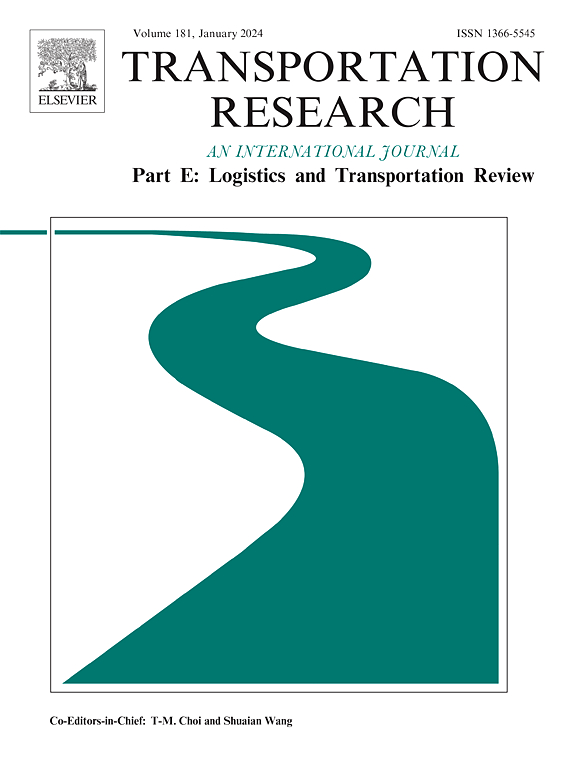基于两阶段随机车队和电池规模的人行道配送机器人路径优化
IF 8.8
1区 工程技术
Q1 ECONOMICS
Transportation Research Part E-Logistics and Transportation Review
Pub Date : 2025-06-11
DOI:10.1016/j.tre.2025.104220
引用次数: 0
摘要
快速增长的在线食品配送(OFD)市场给最后一英里的配送业务带来了巨大的物流挑战。人行道送货机器人(sdr)已经成为按需工人的一个很有前途的替代品,因为这些紧凑的盒子大小的机器人可以通过人行道在短距离内高效地运送食物或杂货。我们提出了一个具有集成电池交换操作的单站SDR系统的两阶段随机优化模型。在第一阶段,采用连续逼近(CA)方法确定最优车队规模和所需的额外可换电池数量。第二阶段的解决方案对于促进第一阶段的方法至关重要。这包括解决路线问题,其中包括更换电池的决定和迟到的处罚。为了解决这个问题,我们开发了一种基于自适应大邻域搜索(ALNS)的定制启发式算法,为第二阶段生成高质量的解决方案。拟合的CA模型集成了关键因素,包括时间窗口,电池更换和皮卡交付订单。数值算例表明,该方法在保持求解精度的同时有效地减少了计算时间。在普渡大学校园进行的案例研究和敏感性分析说明了车队规模和可更换电池数量的实际影响。本文章由计算机程序翻译,如有差异,请以英文原文为准。
Two-stage stochastic fleet and battery sizing with routing optimization for sidewalk delivery robots
The rapidly growing online food delivery (OFD) market presents substantial logistical challenges for last-mile delivery operations. Sidewalk delivery robots (SDRs) have emerged as a promising alternative to on-demand workers, as these compact, box-sized robots efficiently deliver food or groceries over short distances via sidewalks. We propose a two-stage stochastic optimization model for a single-depot SDR system with integrated battery-swapping operations. In the first stage, a continuous approximation (CA) method determines the optimal fleet size and the required number of additional swappable batteries. The second-stage solutions are critical to facilitate the first-stage method. These involve solving a routing problem that incorporates battery-swapping decisions and penalties for late arrivals. To address this, we develop a customized heuristic based on adaptive large neighborhood search (ALNS) to generate high-quality solutions for the second stage. The fitted CA model integrates key factors, including time windows, battery swapping, and pickup-delivery orders. Numerical examples highlight the proposed approach’s efficiency in reducing computational time while maintaining solution accuracy. A case study and sensitivity analysis conducted on Purdue University’s campus illustrate the practical impacts of fleet size and the number of swappable batteries.
求助全文
通过发布文献求助,成功后即可免费获取论文全文。
去求助
来源期刊
CiteScore
16.20
自引率
16.00%
发文量
285
审稿时长
62 days
期刊介绍:
Transportation Research Part E: Logistics and Transportation Review is a reputable journal that publishes high-quality articles covering a wide range of topics in the field of logistics and transportation research. The journal welcomes submissions on various subjects, including transport economics, transport infrastructure and investment appraisal, evaluation of public policies related to transportation, empirical and analytical studies of logistics management practices and performance, logistics and operations models, and logistics and supply chain management.
Part E aims to provide informative and well-researched articles that contribute to the understanding and advancement of the field. The content of the journal is complementary to other prestigious journals in transportation research, such as Transportation Research Part A: Policy and Practice, Part B: Methodological, Part C: Emerging Technologies, Part D: Transport and Environment, and Part F: Traffic Psychology and Behaviour. Together, these journals form a comprehensive and cohesive reference for current research in transportation science.

 求助内容:
求助内容: 应助结果提醒方式:
应助结果提醒方式:


